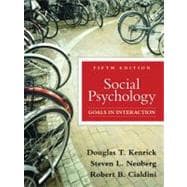Social Psychology: Goals in Interaction explores how social behavior is goal-directed and a result of interactions between the person and the situation.
A unique integrated approach to social behavior: Rather than providing a laundry list of unconnected facts and theories, the authors organize each chapter around the two broad questions:
(1) What are the goals that underlie the behavior in question?
(2) What factors in the person and the situation connect to each goal?
The book thus presents the discipline as a coherent framework for understanding human behavior. The subtitle, Goals in Interactions underscores this integrated approach to understanding behavior.
Opening mysteries: Each chapter begins with a mystery of social behavior, designed not only to grab student interest, but also to organize the ensuing discussion of scientific research: Why did the beautiful and talented artist Frida Kahlo fall for the much older, and much less attractive, Diego Rivera, and then tolerate his numerous extramarital affairs? What psychological forces led the Dalai Lama, the most exalted personage in Tibet, to forge a lifelong friendship with a foreign vagabond openly scorned by Tibetan peasants? Why would a boy falsely confess to murdering his own mother?
Social Psychology: Goals in Interaction introduces the student to the fascinating mysteries of social behavior. By revealing the motives behind social behavior—why people love, hate, lead, and follow, for example—and bridging the person and the social situation, KNC actively engages the students’ natural curiosity while providing the only textbook with a truly integrative, coherent approach.
The latest scholarship, engaging writing, engrossing real-world stories and the authors' strengths as renowned researchers and expert teachers, all come together to make the fifth edition of Social Psychology: Goals in Interaction an accessible and engaging read for students, while providing a modern and cohesive approach for their teachers.








